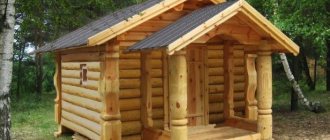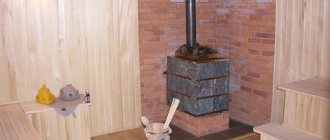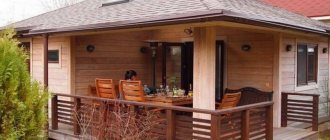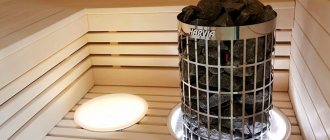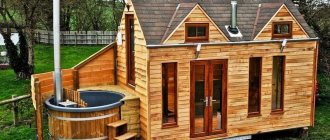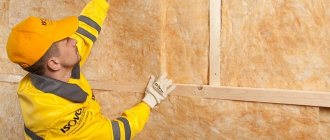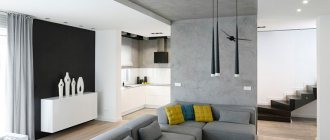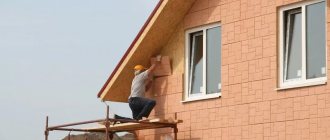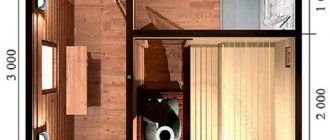17795 2 13
Kikimora November 29, 2016Speciality: I love my home, I like to equip it, periodically change something, do it with my own hands. There are no special hobbies. I am the administrator of a small women's forum.
Traditional Russian bath
If we often leave repairs in the apartment to the shoulders of specialists, for fear of messing up, then decorating a bathhouse with our own hands seems to many not such a serious matter. But is it? The bathhouse consists of several rooms with completely different purposes and requires a serious approach to the selection of materials for each of them. If you are interested in finding out what is the best way to decorate a bathhouse inside and outside, I am ready to share my experience.
How to inexpensively cover the inside of a bathhouse
It will be inexpensive to line the inside of a bathhouse, provided that a person is familiar with the available products. Some of them have significant drawbacks.
To decide how to decorate the inside of a bathhouse cheaply, it is better to look at all the options. Next, the manufacturers that are on the market are evaluated.
Steam room finishing
The finishing of the bathhouse is always carried out according to a similar plan:
- Preparation;
— insulation;
— waterproofing;
— vapor barrier. If you are wondering what is the best way to sheathe the inside of a bathhouse, you should start with one layer. Next, you will be able to decide on waterproofing and vapor barrier. The bathhouse must be protected from the inside; mineral wool alone is not enough.
Bathroom trim
Especially novice builders are curious about how to sheathe a bathhouse in the bathroom area. The following materials are suitable for this:
- tile;
— salt blocks;
- stone.
The bathhouse in the bathroom area must be protected, since the temperature there is high. Fireproof materials differ by class. Wall covering is done in layers, since wool or tiles perform a certain amount of work.
Salt blocks may seem like a strange material to some, but they are becoming increasingly popular in the construction industry. Beginning masters have a desire to learn more about them. Blocks are available in different types:
— 200 by 100 mm;
- 200 by 200 mm.
Among the features is high strength. Salt blocks are easy to process, so you can use a grinder. The unique appearance is taken into account since they have a transparent structure.
You can create a unique atmosphere in the bathhouse. Together with the salt blocks, it will look like an ice castle. The environmental friendliness of the blocks is another plus. Builders understand that the elements can be laid on a concrete surface without any problems.
Additional features:
— durability;
— ease of cleaning;
- resistance to high temperatures.
Salt blocks can be purchased immediately in large quantities. For one product they ask from 250 rubles.
View this post on Instagram
Post from Rinat Salimullin (@rinat_spa)
Arrangement of the rest room
Pressing issues during the construction of a bath include what to decorate the walls with and how to arrange it. Shelves can be arranged in one or several rows. People think about cabinets and a small table.
Experts give their recommendations:
— the walls in the bathhouse should be multi-layered;
— folding structures are used;
- shelves can only be made of wood.
This means that the interior decoration must meet the standards. When construction begins, it is advisable to remember the standards, because depending on the quadrature, the humidity and maximum temperature changes. Bathhouse lining can be inexpensive when the above parameters are calculated.
Additional protection - special compounds and impregnations
Wood is a pleasant-smelling, natural material, which, in addition, gives the bathhouse the appropriate atmosphere of a rustic steam room. Using wood clapboard simplifies the procedure for finishing a bathhouse, and also saves material and costs - covering the walls and ceiling with clapboard will ultimately be cheaper than making a bathhouse from wood or covering it with untreated boards. But the finished finish has a significant drawback - without treatment with waterproofing compounds it will not last long: moisture passes through the connecting seams, settles in the grooves, reaches the vapor barrier material, accumulates on it and provokes the development of mold. To avoid this, you will have to treat the walls, floor and ceiling after finishing with a waterproofing solution.
Protective impregnation will extend the service life of both the finish and the bath itself. The main thing when applying it is to read the manufacturer’s instructions on the packaging and act in accordance with the algorithms specified therein. The safest and most effective waterproofing agents for baths are those containing wax. Water-based impregnations can also be used.
Operating conditions
To cover a steam room, it is important to remember the operating conditions. When contacting surfaces, fire safety standards are observed. As you know, a person can get burned. Installation standards for the bathhouse are met. The materials are securely fixed and, even with high humidity, remain in place and do not expand much. In the sauna you should definitely put signs on things that are prohibited from touching. Inside, in addition to the lining, other materials can be used. Some of them are specially processed.
Furnace installation
The stove in the steam room can be installed in iron, brick or electric. The location for it should be chosen at the bathhouse design stage. The furnace firebox can be located both inside the steam room and outside it.
Installation procedure in a steam iron stove:
install the stove on a pre-prepared base;
#gallery-5 { margin: auto; } #gallery-5 .gallery-item { float: left; margin-top: 10px; text-align: center; width: 50%; } #gallery-5 img { border: 2px solid #cfcfcf; } #gallery-5 .gallery-caption { margin-left: 0; } /* see gallery_shortcode() in wp-includes/media.php */
Base for installing the furnace
Furnace foundation - photo
they line it with bricks along the walls and inside the partition;
#gallery-6 { margin: auto; } #gallery-6 .gallery-item { float: left; margin-top: 10px; text-align: center; width: 50%; } #gallery-6 img { border: 2px solid #cfcfcf; } #gallery-6 .gallery-caption { margin-left: 0; } /* see gallery_shortcode() in wp-includes/media.php */
Brick is laid between the walls of the furnace and the timber, the cracks are sealed with basalt cardboard
The walls near the stove are protected with refractory bricks
a metal passage for the chimney is installed in the opening on the ceiling;
Installed ceiling trim
a pipe and damper are installed on the stove, a tank is connected and a double-walled chimney is brought out through the ceiling, insulating it with non-combustible material;
Ceiling trim is fully insulated
a metal sheet with a hole through which the pipe passes is fixed on the roof.
Chimney passage through the roof
Installation of an electric heater
The electric oven is installed on a pre-prepared platform or hung on the wall using special brackets. It does not require installation of a chimney.
It is imperative to observe the distances specified in the instructions from the oven to the walls and shelves.
Interior decoration of the bathhouse, what is used besides lining
If we consider a Russian bathhouse, the inside is lined with the following materials:
- ceramics;
— block structures;
- wooden panels.
There is always the possibility of replacing the material with another, and combinations are appreciated. So, the upper part can be decorated with panels, and the lower part with blocks.
As you can see, the lining can be replaced with artificial materials. In conditions of high humidity they really show good results. Even new materials such as glass magnesite and salt blocks are suitable for finishing a bath.
It is ceramics that attracts special attention from builders. Peculiarities:
- strength;
— chic appearance;
- environmental friendliness.
When builders choose ceramics, they understand the structure. The blocks contain clay, so they are not afraid of elevated temperatures. They are also not afraid of changes.
If you look at the types, you can find fireclay and majolica. There is a difference in block sizes. Users try to choose an interesting shade so that it looks good in the room.
Additional factors are also taken into account:
— surface smoothness;
— number of layers;
— transparency.
Types such as fireclay and porcelain are the most common.
Alternative finishing materials
It’s interesting what you can use to cover a bathhouse when your budget is very limited. Builders claim that some types of trees are easy to get for next to nothing. Options to choose from:
- Linden;
- birch;
- hemlock.
The dressing room will look great from linden. Don't forget about the unique appearance and pleasant smell. It is inexpensive to make decorations from birch. It is important to choose materials without knots.
That the room looked beautiful, hemlock is suitable. The type of wood became especially widespread in America. Now there is so much of it that a batch for walls in a bathhouse can be obtained at a low price.
If we look at linden in more detail, we can note the following advantages:
— lightness;
- variety of shades;
- high density.
Despite the high density, the material breathes. Builders try to make the sheathing from oak or other wood. The most important thing is to use appropriate insulation that will not affect adjacent layers.
When processing, you should follow standard tips. First, the surface is cleaned. The cut can be made at a slight angle. If you need to grind down the edges, sandpaper will do.
Some people are interested in special grinding machines to work faster. On a construction site, you should always have a good saw on hand. Workpieces usually have to be divided at right angles.
If we consider the features, it is worth highlighting the following:
- low density of cheap varieties;
- limited service life compared to other breeds.
Craftsmen point out that without impregnation, linden behaves unpredictably.
Steam room
Dense types of wood feel comfortable in a wooden steam room. The following are actively offered on the market:
- Linden;
- aspen;
- alder.
The first option is definitely inexpensive. It will be possible to take it with a reserve, but the entire batch is checked. A cheap sheet may initially have traces of mechanical damage.
Aspen is definitely suitable if you immediately consider all the advantages:
- environmental friendliness;
- subtle smell;
- resistance to moisture.
Some people like the fact that aspen, with proper dexterity, bends. Thus, it is possible to design interesting transitions. Some people get creative with the process and work on arches.
Aspen can be used with other species, the main thing is to watch the joints. Another point is ease of use. If you look at the surface, it rarely gets dirty. Various impregnations can be used for processing.
Washing
The beautiful appearance of a bath depends on the washing room, among other things. Popular offers:
- croaker;
- Linden;
- spruce.
If you cover the sink with a slab, you should be prepared for a long installation. It should be recognized that some breeds are not very easy to process. The wall will turn out beautiful if you use special protective equipment, and it is important to remember about the adhesive base.
Linden is definitely suitable for construction, if you take into account a number of features:
— lightness;
— porosity;
- color change.
Thus, linden is suitable for indoor use, but you should be prepared for the surface to change color over time. Some consider this a significant drawback. Others see their advantages in darkened wood.
The most important thing is that linden can be processed with ordinary tools. Even if you take a large file, the teeth will not tear the fibers. At the same time, you will have to make efforts to achieve effective work.
If it is important to make the cut at a slight angle, it is better to use a device. This way you can fix the board.
Restroom
A properly decorated rest room is pleasing to the eye. It all starts with the material, and here the following options are good:
- alder;
- Linden;
- spruce.
As always, the material must meet the standards. Blanks must be checked manually; dimensions are important. Wooden wood with a lot of chips can be immediately put aside.
The most interesting thing is that the above wood species are similar in many ways. However, when finishing the rest room according to the instructions, it is worth considering the type of the final result.
Tile installation technology
If we are talking about laying tiles on the floor, then the floor area is first filled with cement mortar at a slight slope towards the drainage system. The perimeter of the sauna is framed with construction twine. The tilting technology depends on the first tile from which the further floor angle is measured.
When laying, you can use a special tile adhesive, but a prerequisite for ensuring no subsidence is the addition of sand granules
If the tile is laid on a cement-sand mortar, then before laying it is immersed in water for 10 hours.
When installing ceramics on the screen around the furnace, heat-resistant thick glue is used. If the mastic is runny, it is better to make it thicker by adding sand. Wall tiles are laid in rows from bottom to top level.
Regardless of the purpose for which the bathhouse is being built - personal use or business, the task of properly equipping the steam room is considered the main one on the to-do list. Compliance with the necessary standards will guarantee a long, safe, pleasant use of the Russian bath.
How and with what materials to decorate the pros and cons of natural and artificial
If a sauna or bath is considered, the most worthy materials are considered to be the following:
— lining;
- tile;
- stone.
Many people have a desire to use natural materials. The following advantages are noted:
- environmental friendliness;
- nice smell.
Minuses:
- scarce types of lining;
- a large percentage of defects.
There is a need to cover the bathhouse with artificial materials, it is also important to remember the advantages:
- high quality;
- durability.
Minuses:
- not a pleasant smell;
- cheap look.
Thus, natural and artificial options have many advantages and disadvantages.
Features of wood cladding
I wonder how to line the inside of a bathhouse cheaply. Wood comes first, but it has a number of features:
- many types;
- inexpensive fasteners are suitable;
- Possibility of using glue.
Finishing the inside of a bathhouse using wood assumes that the master is familiar with the material. It is important to know about expansion, mechanical properties. Practice shows that lining the inside of a bathhouse can take longer if the percentage for defects is not calculated.
Many people are interested in how to line a bathhouse from the inside in order to spend a minimum of time on work. In terms of ease of processing, coniferous species are valued.
View this post on Instagram
Publication from Sib-Stroi-Comfort (@sib_stroi_komfort)
Steam room materials
The internal appearance of the bathhouse largely depends on the steam room. It is worth evaluating all the options, but the following are in greatest demand:
- Finnish spruce;
- pine;
- beech.
The steam room must be prepared and a film is laid in front of the main layers. Alder, aspen and beech are suitable as the main insulation. You can additionally consider cedar, but it is now rising in price.
Even professionals are interested in how to line a bathhouse in order to save as much as possible. In this regard, linden comes first.
If we look at pine in more detail, it has the following features:
- strength;
— durability;
- heat retention.
In terms of moisture, the indicators are at the level of oak. Impregnated material will last about 10 years. Over time, pine does not lose color. As for the smell, it changes.
Characteristics:
— bending up to 80 MPa;
— density 450 kg per cubic meter.
Pine has average compression performance. The fibers hold up well during sudden temperature changes. If you take a board, the tensile strength is 90 MPa.
Builders are familiar with the need to handle clapboard carefully. If workpieces of small thickness are used, there is a high probability of chipping. For example, you need to divide the lining, and for this it makes sense to take a file with fine teeth.
View this post on Instagram
Publication from Upholstering SAUNA IN KAZAN (@kluchksaune)
Washing material
If you are curious about how to line the inside of a bathhouse, the following is considered for the washing room:
- fake diamond;
- pine panels;
- hemlock.
If the steam room is easy to cover with thin sheets of aspen, then you can approach the washing room in an original way. PVC panels and even ceramics are valued. It’s interesting how to line the inside of a bathhouse in addition to the above methods. Here, planken acts as an alternative.
Material for the rest room
I'm always curious about how to line the inside of a bathhouse cheaply and beautifully. For the rest room, the following methods come first:
- brick;
— lining;
- siding.
The inside of the bathhouse is decorated in the same style. For example, lining and brick practically do not go together. If you take siding, PVC panels will do. When considering a bathhouse, the finishing must be calculated in advance.
Lining does not require a large percentage of inventory. Some are interested in how to line the inside of a bathhouse so as not to attract help. It is easier to choose a brick from the above methods.
Next, we take into account what the craftsman uses to line the inside of the bathhouse. First on the list is lining of different types.
The process of covering walls with clapboard step-by-step instructions
If previously the question of how to line the inside of the dressing room inexpensively was of interest, now it’s worth considering the process itself.
Instructions:
- Preparation;
- the basis;
- covering the inside of the bathhouse with the first layer;
- isolation.
Wall cladding in a bathhouse begins with preparation, since the surface must be cleaned.
View this post on Instagram
Publication from Rinat Salimullin (@rinat_spa)
Methods for attaching panels to walls
Using nails or self-tapping screws is the traditional option for attaching panels to walls. A more modern method is the use of clamps. It does not damage the panels, but requires additional costs of both time and money when installing the lining.
Using nails or screws
This method will require a screwdriver or hammer, as well as special nails or self-tapping screws - galvanized or made of copper alloy. Such fittings are more expensive, but if you save on them and buy ordinary nails, they will begin to rust over time. This will lead to the appearance of red streaks on the lining, which will spoil the appearance of the finish and stain the skin and things when touched. The fasteners are driven or screwed into the lining tenon at an angle of 45 degrees. The fastening points will have to be sanded so that there are no burrs or other defects left. The disadvantage of this method is that holes will have to be created on the planks when fastening them with nails. And when you try to remove the lining, the fastening points will be further damaged, which precludes the reuse of the panels if necessary.
Fastening with clamps
Do-it-yourself installation using clamps is safe for lining strips because it does not damage them. A clamp is a special bracket that is attached to the lower half of the lining groove - a recess into which the tenon of the next plank is inserted. The fastenings of the bracket are covered with the next strip in the row. Fixing the staples to the sheathing beams is carried out with nails or self-tapping screws.
With this installation method, the lining is not damaged, and there are no nail heads or screws left on the outer surface of the cladding, which eliminates the risk of getting burned or getting a rusty drip on your clothes after visiting such a bathhouse.
It is also easier to partially replace the lining mounted in this way - just pull the boards out of the grooves and pull out the fasteners. If you do not work carefully, it will be the staples that are damaged, not the boards.
We recommend reading:
Fiber optic bath lighting
What not to insulate and sheath a steam room
Many people wonder what can be used to line the inside of a bathhouse. However, it is equally important to consider what not to use.
Methods:
- foam;
- plastic;
- PVC films.
It is easy to line the inside of a bathhouse with plastic, but this material is not suitable. Films can only be used as intermediate options. When asked how to decorate the inside of a bathhouse cheaply, it is worth talking about different methods, but avoid flammable objects.
Some are curious to learn more about PVC film. As the temperature rises, this finish in the bathhouse will change. Since the layers are bonded, the entire insulation is affected.
When deciding what to cover the inside of the bathhouse with, other than lining, it is worth remembering safety. Natural objects without impregnation pose a danger indoors.
Which tree to choose for a bath
Craftsmen are often asked the question of how to line the inside of a bathhouse inexpensively. The following types of wood come to mind:
- alder;
- oak;
- pine.
When you are interested in how to decorate the walls in a bathhouse, it is worth remembering the basic properties. We are talking about strength and moisture resistance. The wooden inner lining of the bathhouse should not lose its properties even at elevated temperatures.
View this post on Instagram
Publication from Rinat Salimullin (@rinat_spa)
Oak
If the question of what is used to line a bathhouse is interesting, it is worth evaluating oak.
Pros:
— interesting structure;
- nice smell;
- Possibility of simplified installation.
When asked how to sheathe the inside of a bathhouse, most often craftsmen talk about the need to clean the surface. First, preparation is carried out and all hangnails are removed.
Thus, the question of how to line a steam room inside a bathhouse is more relevant than ever. The price for oak starts from 20 thousand rubles. per cubic meter.
Linden
Linden is ideal for baths for the following reasons:
- variety of shades;
— ease of processing;
- boards of different sizes.
If you are interested in what is the best way to line the inside of a bathhouse, it is important to immediately evaluate the prices of linden. The 30 by 90 by 1000 mm format remains in demand. On the Internet, you can enter a query about how to line the inside of a bathhouse, and suggestions about linden will quickly appear. One board costs from 100 rubles.
Aspen
Aspen remains in demand for baths due to the following advantages:
- dense structure;
- different formats;
- Possibility of installation yourself.
When people are interested in how to decorate the inside of a bathhouse, aspen often comes to mind. They try to be objective, since for one piece they will have to pay from 150 rubles. If you consider how to decorate a bathhouse, aspen is surprised by its environmental friendliness. Some people choose it because of the smell. This lining for a bathhouse inside can be interesting in combination with other types of wood.
As an option, consider birch or beech. The finishing in the bathhouse is prepared by polishing.
Alder
The first question to the master is how to line the inside of the sauna. Alder is an amazing breed that has the following advantages:
- lovely drawing;
— moisture resistance;
- durability over many years.
Now, when they ask what to decorate the inside of the bathhouse with besides the lining, we can safely say about alder. Options available starting at RUB 150. for the workpiece.
If you search, the interior decoration of baths is available in different formats. If combination options are interesting, beech or pine is considered. Now it’s clear how to decorate the inside of the bathhouse, but it’s important to find a trusted supplier.
Cedar
It’s difficult to immediately figure out what can be used to cover a bathhouse. Cedar itself is not impressive in its properties, but it has the following advantages:
— low conductivity;
— the material breathes;
- not afraid of high temperatures.
The inside of a sauna with cedar looks special.
Larch
If you are interested, the interior decoration of the bathhouse, materials, larch should not be considered the last thing. She has the following advantages:
— good structure;
- smooth surface;
- presence of resins.
When asked what to line the inside of a bathhouse with, it’s worth looking at larch in more detail. Coniferous trees additionally have medicinal properties. If you are interested in the best way to sheathe the inside of a bathhouse, it is better to decide on several options. Larch can be combined with beech or oak.
Pine
The next question is what can be used to line the inside of a bathhouse. Pine is considered an excellent candidate, because the following advantages are noted:
- adheres well to nails;
— does not lose color;
- resistance to moisture.
Such lining of the baths inside attracts attention with its appearance. Pine harmonizes with other types of trees. When asked what can be used to line the inside of a bathhouse inexpensively, it is worth pointing out the combinations - pine and cedar, pine and spruce.
Basic requirements for wood wall coverings
When choosing a lining, you need to consider a number of requirements:
Moisture resistance. The boards must be resistant to moisture, so that premature rotting does not begin, and dry quickly, which also protects them from rot. Smoothness. High-quality lining has a flat, smooth surface. The absence of knots, gaps, and roughness eliminates the risk of mechanical damage to the skin and penetration of excess moisture into the coating. Low thermal conductivity
An important quality, since you can get burned on wood that is too hot. Hygiene. The wood should be easy to clean.
It is better to choose linden for the steam room, since it is easy to clean, has low thermal conductivity, and has beneficial properties. Larch also meets most requirements. Low thermal conductivity, strength, density, positive effect on the body, and moisture resistance make larch stand out among other species.
According to experienced builders, it is better to use African oak (abashi). Low thermal conductivity, strength, lightness, resistance to rotting and deformation, absence of chips, cracks, beautiful wood pattern of abashi make it a bestseller, but there is one drawback - too high cost.
Wood should not be treated with stain, varnish, or other chemicals, since when the air is heated they will release harmful substances.
Selection of lining
